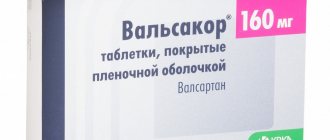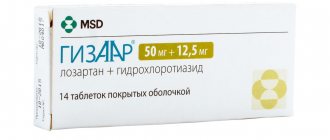Valsacor N160
Combined antihypertensive drug.
Valsartan is a selective angiotensin II receptor antagonist of non-protein nature.
It has a selective antagonistic effect on receptors of the AT1 subtype. The consequence of AT1 receptor blockade is an increase in the plasma concentration of angiotensin II, which can stimulate unblocked AT2 receptors, which balances the effects associated with stimulation of AT1 receptors.
Valsartan does not have agonist activity against AT1 receptors. Its affinity for receptors of the AT1 subtype is approximately 20,000 times greater than for receptors of the AT2 subtype. Valsartan does not inhibit ACE, also known as kininase II, which converts angiotensin I to angiotensin II and destroys bradykinin. Due to the lack of influence on ACE, the effects of bradykinin and substance P are not potentiated, therefore, when taking apgiotensin II receptor antagonists, the development of a dry cough is unlikely. Valsartan does not interact with or block other hormone receptors or ion channels involved in regulating the function of the cardiovascular system.
In the treatment of arterial hypertension, valsartan reduces blood pressure without affecting heart rate.
After oral administration of a single dose of valsartan, the antihypertensive effect develops within 2 hours, and the maximum reduction in blood pressure is achieved within 4-6 hours.
The antihypertensive effect of valsartan lasts for 24 hours. With repeated prescriptions of valsartan, the maximum reduction in blood pressure, regardless of the dose, is achieved after 2-4 weeks and remains at the achieved level during long-term therapy. The combination with hydrochlorothiazide allows you to achieve a significant additional reduction in blood pressure.
Sudden cessation of valsartan is not accompanied by a withdrawal syndrome (a sharp rise in blood pressure or other undesirable clinical consequences).
Hydrochlorothiazide is a thiazide diuretic, the diuretic effect of which is associated with impaired reabsorption of sodium, chlorine, potassium, magnesium, and water ions in the distal nephron; delays the excretion of calcium ions and uric acid. It has a hypotensive effect, which is caused by the expansion of arterioles. It has virtually no effect on normal blood pressure levels.
The diuretic effect develops 1-2 hours after taking the drug orally, reaches a maximum after 4 hours and persists for 6-12 hours. The antihypertensive effect occurs after 3-4 days, but it may take 3-4 weeks to achieve the optimal therapeutic effect.
Instructions for use VALSACOR® H160
Combined antihypertensive drug.
Valsartan/hydrochlorothiazide
In a double-blind, randomized, active-controlled study, patients who failed to achieve adequate BP control with hydrochlorothiazide 12.5 mg received a combination of valsartan/hydrochlorothiazide 160/12.5 mg had a decrease in mean BP (12.4/7.5 mmHg). ) compared with patients receiving only hydrochlorothiazide at a dose of 25 mg (5.2/2.1 mmHg). In addition, a greater number of patients (%) experienced a hypotensive effect on therapy with the combination of valsartan/hydrochlorothiazide 160/12.5 mg (diastolic blood pressure <140/90 mm Hg or a decrease in SBP ≥20 mm Hg or DBP ≥10 mm Hg .st.) (50%) compared to taking hydrochlorothiazide at a dose of 25 mg (25%).
In a double-blind, randomized, active-controlled study, patients who failed to achieve adequate BP control with valsartan 160 mg received a combination of valsartan/hydrochlorothiazide 160/12.5 mg had a decrease in mean BP (14.6/11.9 mmHg). ) compared with patients receiving only valsartan at a dose of 160 mg (8.7/8.8 mmHg). The difference in blood pressure reduction when comparing doses of 160/25 mg and 160/12.5 mg reached statistical significance. In addition, a greater number of patients (%) experienced a hypotensive effect (diastolic blood pressure <90 mmHg or decrease ≥10 mmHg) to therapy with the combination of valsartan/hydrochlorothiazide 160/25 mg (68%) and 160/ 12.5 mg compared to valsartan 160 mg (49%).
A double-blind, randomized, placebo-controlled, factorial design study compared different doses of valsartan/hydrochlorothiazide combinations with their respective components. When comparing placebo (1.9/4.1 mmHg), hydrochlorothiazide at a dose of 12.5 mg (7.3/7.2 mmHg), hydrochlorothiazide at a dose of 25 mg (12.7/9.3 mmHg) and valsartan at a dose of 160 mg (12.1/9.4 mmHg) the greatest decrease in mean blood pressure was observed when taking the combination of valsartan/hydrochlorothiazide 160/12.5 mg (17.8/13.5 mmHg) and 160/25 mg (22.5/15.3 mmHg) . In addition, a greater number of patients (%) experienced a hypotensive effect (diastolic blood pressure <90 mmHg or a decrease ≥10 mmHg) to therapy with the combination of valsartan/hydrochlorothiazide 160/12.5 mg (81%) and 160/ 12.5 mg (76%) compared with placebo (29%) and corresponding monotherapy with hydrochlorothiazide 12.5 mg (41%), 25 mg (54%), valsartan 160 mg (59%).
In controlled clinical studies of the combination of valsartan/hydrochlorothiazide, a dose-dependent decrease in serum potassium was observed. A decrease in serum potassium was observed more often in patients receiving hydrochlorothiazide at a dose of 25 mg than in patients receiving hydrochlorothiazide at a dose of 12.5 mg.
In controlled clinical trials of the valsartan/hydrochlorothiazide combination, the hypokalemic effect of hydrochlorothiazide was reduced as a result of the potassium-sparing effect of valsartan.
The beneficial effects of valsartan in combination with hydrochlorothiazide on cardiovascular mortality and morbidity are currently unknown. Epidemiological studies have shown that long-term treatment with hydrochlorothiazide reduces the risk of cardiovascular mortality and morbidity.
Valsartan
Valsartan is a selective angiotensin II receptor antagonist for oral administration. It has a selective antagonistic effect on receptors of the AT1 subtype. A consequence of AT1 receptor blockade is an increase in plasma concentrations of angiotensin II, which can stimulate unblocked AT2 receptors, which is believed to regulate the effects of AT1 receptors. Valsartan does not have agonist activity against AT1 receptors. Its affinity for receptors of the AT1 subtype is approximately 20,000 times greater than for receptors of the AT2 subtype. Valsartan does not interact with or block other hormone receptors or ion channels involved in regulating the function of the cardiovascular system.
Valsartan does not inhibit ACE, also known as kininase II, which converts angiotensin I to angiotensin II and destroys bradykinin. Due to the lack of influence on ACE, the effects of bradykinin and substance P are not potentiated, therefore, when taking angiotensin II receptor antagonists, the development of a dry cough is unlikely.
Clinical studies in which valsartan was compared with an ACE inhibitor showed that the incidence of dry cough was significantly lower in patients receiving valsartan compared to patients receiving an ACE inhibitor (2.6% versus 7.9%, respectively, p>0.05). In clinical trials in patients with a history of cough during ACE inhibitor therapy, dry cough was observed in 19.5% of patients switched to valsartan and 19% of patients treated with thiazide diuretics, compared with 68.5% of patients treated with an ACE inhibitor (p>0.05).
In the treatment of arterial hypertension, valsartan reduces blood pressure without affecting heart rate.
In most patients, after oral administration of a single dose of valsartan, the antihypertensive effect develops within 2 hours, and the maximum reduction in blood pressure is achieved within 4-6 hours. The antihypertensive effect of valsartan persists for 24 hours. With repeated prescriptions of valsartan, the maximum decrease in blood pressure is achieved, regardless of the dose , is achieved after 2-4 weeks and remains at the achieved level during long-term therapy. In combination with hydrochlorothiazide, a significant additional reduction in blood pressure is achieved.
Abrupt withdrawal of valsartan is not accompanied by rebound hypertension or other adverse clinical events.
During observations, it was revealed that as a result of the use of valsartan in patients with type 2 diabetes mellitus and microalbuminuria, protein excretion in the urine decreases. The MARVAL (Microalbuminuria Reduction with Valsartan) study assessed the reduction in urinary protein excretion with valsartan (80-160 mg once daily) compared with amlodipine (5-10 mg once daily) in 332 patients with type 2 diabetes mellitus (average age 58 years; 265 male patients) with microalbuminuria (valsartan - 58 mcg/min; amlodipine - 55.4 mcg/min), normal or elevated blood pressure and preserved renal function (blood creatinine <120 μmol/l) . At 24 weeks, urinary protein excretion decreased (p<0.001) by 42% (-24.2 μg/min; 95% CI:
- -40.4 to -19.1) when using valsartan and approximately 3% (-1.7 mcg/min;
- 95% CI: -5.5 to 14.9) with amlodipine, despite the same level of blood pressure reduction in both groups.
The DROP (The Diovan Reduction of Proteinuria) study continued to study the effectiveness of valsartan in reducing urinary protein excretion in 391 patients with arterial hypertension (BP 150/88 mm Hg) and type 2 diabetes mellitus, albuminuria (mean value - 102 µg/min; 20-700 µg/min) and preserved renal function (mean serum creatinine = 80 µmol/L). Patients were randomized to receive one of 3 doses of valsartan (160, 320, and 640 mg once daily) and were treated for 30 weeks. The purpose of the study was to establish the optimal dose of valsartan to reduce urinary protein excretion in hypertensive patients with type 2 diabetes mellitus. At 30 weeks, the percentage change in urinary protein excretion was significantly reduced by 36% from baseline with valsartan 160 mg (95% CI: 22 to 47%), with a 44% reduction with valsartan 320 mg. (95% CI:
- 31 to 54%). It was concluded that the use of valsartan 160-320 mg caused a clinically significant reduction in urinary protein excretion in patients with hypertension and type 2 diabetes mellitus.
Two large randomized controlled trials, ONTARGET (ONgoing Telmisartan Alone and incombination with Ramipril Global Endpoint Trial) and VA NEPHRON-D (The Veterans Affairs Nephropathy in Diabetes), examined the use of ACE inhibitors in combination with angiotensin II receptor antagonists.
The ONTARGET study was conducted in patients with cardiovascular disease, cerebrovascular disease, or type 2 diabetes with evidence of end-organ damage.
The VA NEPHRON-D study was conducted in patients suffering from type 2 diabetes mellitus and diabetic nephropathy.
Compared with monotherapy, these studies did not show significant beneficial effects on renal function and/or cardiovascular outcomes and mortality, while an increased risk of hyperkalemia, acute renal failure and/or hypotension was observed. Due to similar pharmacodynamic properties, these results are relevant to other ACE inhibitors and angiotensin II receptor antagonists. Therefore, ACE inhibitors and angiotensin II receptor antagonists should not be used simultaneously in patients with diabetic nephropathy.
The ALTITUDE (Aliskiren Trial in Type 2 Diabetes Using Cardiovascular and Renal Disease End points) study was designed to determine the benefits of adding aliskiren to standard ACE inhibitor or angiotensin II receptor antagonist therapy in patients with type 2 diabetes mellitus, chronic renal failure, cardiovascular diseases. The study was stopped early due to an increased risk of adverse outcomes. Stroke and cardiovascular mortality were observed more often in the aliskiren group than in the placebo group. Also, in the group taking aliskiren, undesirable side effects (hyperkalemia, hypotension, renal dysfunction) were more often observed.
Hydrochlorothiazide
Hydrochlorothiazide is a thiazide diuretic whose site of action is primarily in the distal renal tubules. In the renal cortex there are receptors that have high affinity and are the main binding site for thiazide diuretics, where the transport of NaCl into the distal tubules is suppressed. The mechanism of action of thiazides is due to inhibition of the cotransport of Na+ and Cl- ions, possibly due to competition for Cl- transport sites, which affects the mechanisms of electrolyte reabsorption:
- the excretion of sodium and chloride ions increases approximately equally in direct proportion. Indirectly, as a result of this diuretic effect, there is a decrease in plasma volume, resulting in increased renin activity, aldosterone secretion, and urinary excretion of potassium, resulting in a decrease in serum potassium concentration.
The relationship between renin and aldosterone is mediated by angiotensin II, therefore, with simultaneous use of valsartan, the decrease in serum potassium concentration is less pronounced than with the use of hydrochlorothiazide as monotherapy.
Non-melanoma skin cancer (NMSC)
Based on available data from epidemiological studies, there is a cumulative dose-dependent association between hydrochlorothiazide and NMSC. One study included a population of 71,533 cases of basal cell carcinoma and 8,629 cases of squamous cell carcinoma matched to 1,430,833 and 172,462 control populations, respectively. High-dose hydrochlorothiazide (cumulative ≥50,000 mg) was associated with an adjusted OR of 1.29 (95% CI: 1.23–1.35) for basal cell carcinoma and 3.98 (95% CI: 3.68–4.31) for squamous cell carcinoma. A clear dose-response relationship was observed for both basal cell carcinoma and squamous cell carcinoma. Another study showed a possible association between lip cancer (SCC) and HCTZ exposure: 633 cases of lip cancer were matched to 63,067 population controls using a risk-adjusted sampling strategy. A cumulative dose-response relationship was demonstrated with an adjusted OR of 2.1 (95% CI:
- 1.7-2.6), increasing to OR 3.9 (3.0-4.9) for the highest cumulative dose (~25,000 mg) and OR 7.7 (5.7-10.5) for the highest cumulative dose (~100,000 mg).







